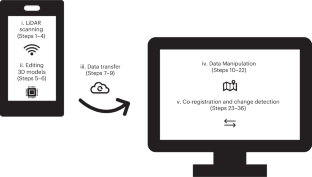利用 iPhone 激光雷达进行高分辨率地形测量和变化探测。
IF 16
1区 生物学
Q1 BIOCHEMICAL RESEARCH METHODS
引用次数: 0
摘要
本文介绍了一种综合协议,利用开放存取技术,通过 iPhone 和 iPad 的光探测与测距(LiDAR)创建中小尺度的环境三维图像。该协议重点关注 iPhone 激光雷达的两项功能。第一项功能是三维建模:iPhone LiDAR 可快速生成详细的室内和室外三维模型,让用户深入了解物体的大小、体积和几何形状。第二项功能是变化检测:激光雷达传感器创建的三维模型可用于精确测量随时间发生的变化。与其他三维地形测量方法相比,这种方法速度快、分辨率高、成本低且易于使用。该规程概述了 iPhone 激光雷达扫描操作、模型导出和变化检测。执行该规程后的预期结果是:(i) 一个中小型物体或感兴趣区域的详细三维模型;(ii) 一个距离点云,显示同一物体或区域的两个点云在不同时间之间的变化。任何人只要拥有一部装有激光雷达传感器的 iPhone 和一台电脑,就能在 2 小时内完成整个程序。该协议为科学家、学生和社区成员开展研究提供了一种廉价、易用的方法,可用于解决一系列问题和挑战,从而使专家和更广泛的社区受益。本文章由计算机程序翻译,如有差异,请以英文原文为准。


High-resolution topographic surveying and change detection with the iPhone LiDAR
This paper introduces a comprehensive protocol leveraging open-access techniques to create small- to medium-scale 3D representations of the environment by using iPhone and iPad light detection and ranging (LiDAR). The protocol focuses on two capabilities of the iPhone LiDAR. The first capability is 3D modeling: iPhone LiDAR rapidly generates detailed indoor and outdoor 3D models, providing insights into object size, volume and geometry. The second capability is change detection: the 3D models created by the LiDAR sensor can be used for precise measurement of changes over time. Compared to other 3D topographic surveying methods, this method is rapid, high resolution, low cost and easy to use. The protocol outlines iPhone LiDAR scanning practices, model export and change detection. The expected results after executing the protocol are (i) a detailed 3D model of a small- to medium-sized object or area of interest and (ii) a distance point cloud revealing change between two point clouds of the same object or area between different times. The entire protocol can be conducted within 2 h by anyone with an iPhone with the LiDAR sensor and a computer. This protocol empowers scientists, students and community members conducting research with a cheap, easy-to-use method for addressing a range of questions and challenges, thus benefiting experts and the broader community. This protocol describes the use of iPhone LiDAR to generate high-resolution 3D models for topographic surveying and to measure their changes over time. The protocol simplifies the use of the iPhone LiDAR sensor, making it accessible to non-experts.
求助全文
通过发布文献求助,成功后即可免费获取论文全文。
去求助
来源期刊

Nature Protocols
生物-生化研究方法
CiteScore
29.10
自引率
0.70%
发文量
128
审稿时长
4 months
期刊介绍:
Nature Protocols focuses on publishing protocols used to address significant biological and biomedical science research questions, including methods grounded in physics and chemistry with practical applications to biological problems. The journal caters to a primary audience of research scientists and, as such, exclusively publishes protocols with research applications. Protocols primarily aimed at influencing patient management and treatment decisions are not featured.
The specific techniques covered encompass a wide range, including but not limited to: Biochemistry, Cell biology, Cell culture, Chemical modification, Computational biology, Developmental biology, Epigenomics, Genetic analysis, Genetic modification, Genomics, Imaging, Immunology, Isolation, purification, and separation, Lipidomics, Metabolomics, Microbiology, Model organisms, Nanotechnology, Neuroscience, Nucleic-acid-based molecular biology, Pharmacology, Plant biology, Protein analysis, Proteomics, Spectroscopy, Structural biology, Synthetic chemistry, Tissue culture, Toxicology, and Virology.
 求助内容:
求助内容: 应助结果提醒方式:
应助结果提醒方式:


